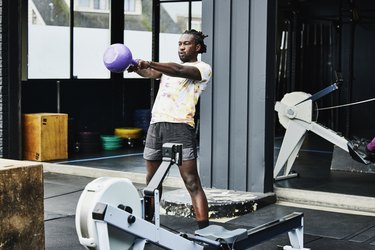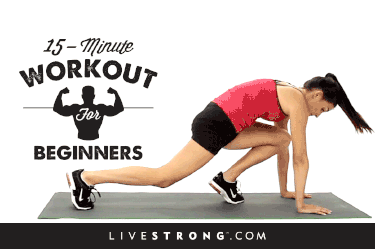
When you hear "metabolic workout," doing a long and intense endurance workout that melts body fat probably pops into your head. But a metabolic workout is actually not quite what it sounds like.
"Metabolic workouts essentially condense the intensity of a full workout into a shorter session that incorporates high-intensity and compound movements with minimal rest periods," Brittany Leboeuf, PhD, a research scientist at Orangetheory Fitness, tells LIVESTRONG.com.
Video of the Day
"This usually isn't a leisurely jog on the treadmill or an hour-long lifting session. Instead, metabolic workouts allow you to tap into immediate and intermediate energy systems, enabling you to maximize your output in a shorter time frame and making every second count."
According to the American Council on Exercise (ACE), your body converts energy from food into adenosine triphosphate, otherwise known as ATP, which is an immediate form of energy.
There are three main energy systems that store ATP in the body: phosphagen, anaerobic and aerobic, per the ACE. The phosphagen system provides an immediate source of ATP, but it has very limited amounts that are used during short high-intensity exercises.
Then there's anaerobic glycolysis, which doesn't need oxygen and breaks down glucose to produce ATP for activities that last 30 seconds to three minutes. Lower-intensity and longer workouts require aerobic glycolysis for ATP; this energy system kicks in when the phosphagen and anaerobic systems tap out.
Because metabolic training is done in a short amount of time with minimal rest, it blends the use of all three energy systems — with the middle pathway being the primary one. Therefore, it's efficient and effective.
Benefits of Metabolic Workouts
1. They're Time-Saving
Unlike a lifting session, where you're doing one exercise for a certain number of reps and sets and have a rest period in between, metabolic workouts focus on quick, muscle-strengthening exercises with minimal rest, Leboeuf says. This translates to a more time-efficient workout.
"You're going all-in for a shorter period with metabolic workouts, but the payoff is huge. It's like a power hour for your body and is ideal for anyone with a busy schedule," Leboeuf says. "By increasing the intensity and minimizing rest, metabolic workouts challenge you to push yourself for a short time for maximum benefits."
2. They Improve Your Cardiorespiratory Fitness
Unlike traditional cardio, like walking or running, which target long-term energy pathways through steady-state exercise, metabolic workouts are done at a high intensity, providing major perks for your cardiorespiratory fitness.
When you're doing a metabolic workout, aim for an 8 out of 10 on the rating of perceived exertion (RPE) scale, where one is an easy walk in the park and 10 is an all-out sprint, Leboeuf says. The benefit of using the RPE scale is that you can turn up (or down) the intensity of an exercise based on how hard you're pushing yourself.
3. They Help You Burn Fat and Build Lean Muscle
Because you're incorporating both cardio and strength components, metabolic workouts also help reduce your body fat and build lean muscle mass.
"Metabolic workouts can also do a lot in terms of promoting a healthy body composition. Whether hitting high-intensity intervals or participating in regular weight training, you're making strides toward reducing your body fat percentage and gaining lean muscle mass," Leboeuf says.
A 15-Minute Metabolic Workout
This 15-minute metabolic workout, designed by Vincent Emanuele, a NASM-certified personal trainer and workout design specialist at Orangetheory Fitness, targets your entire body with just five simple moves.
"These movements are game changers because they target multiple muscle groups, leading to more energy expenditure, better fat loss and amplified muscle engagement," Emanuele says.
"We're also training the body through various planes of motion. This is incredibly important when structuring a balanced routine because we're not just working those 'mirror muscles' that you can see on the outside but engaging those often-neglected, deep, stabilizing muscles that you use in your day-to-day life," he says. "Think of it as giving your entire physique, inside and out, the attention it deserves."
Do each exercise for one minute (30 seconds per side) for a 5-minute round. The goal is to do three rounds as quickly as possible — with good form and minimal rest — in 15 minutes. Use the first round as a benchmark and aim to finish the other two sets in less time — fewer seconds or minutes, Emanuele says. You'll need one moderate-weight dumbbell.
1. Single-Arm Dumbbell Thruster
- Stand with your feet hip-width apart and hold a dumbbell with your right arm in the front-rack position.
- Brace your core and lower your butt back and down until your thighs are parallel to the ground (or as low as you can comfortably go).
- Push your feet into the ground to stand back up and press the dumbbell overhead, finishing with your biceps by your ears.
- Lower the dumbbell back to the front-rack position. This is 1 rep.
- After 30 seconds, repeat on the left side.
Tip
If you can't do an overhead press, modify this exercise with a single-arm front squat.
2. Forward Lunge With Wood Chop
- Stand with your feet hip-width apart and hold each end of a dumbbell by your right shoulder.
- Take a big step forward with your left leg and lower until your front and back legs form 90-degree angles.
- At the same time, bring the dumbbell across your body in a diagonal and twist your torso to the left side until your hands are outside of your left thigh.
- Press your left foot into the ground to stand back up and return the weight to the starting position. This is 1 rep.
- After 30 seconds, switch sides.
Tip
If you're not able to do a wood chop, take it out of the exercise and just do a forward lunge or a body-weight reverse lunge.
3. Hip Hinge Swing
- Hold one end of a dumbbell with both hands and stand with your feet a little wider than hip-width apart.
- Hinge your hips back and bring your torso forward, maintaining a flat back, to hike the dumbbell between your legs.
- As you come up to a standing plank, squeeze your glutes and quads and brace your core. Your arms should be straight, and the dumbbell should come up to chest height.
- Repeat for 60 seconds.
Tip
Swings can be hard to perfect (feel free to use a kettlebell if that's easier), so if you're struggling with your form, swap in a glute bridge or sumo squat, Emanuele suggests.
4. Glute Bridge Hold With Pullover
- Lie down on your back with your knees bent and feet flat on the floor. Hold one end of the dumbbell with both hands and extend your arms overhead.
- Press your feet into the ground and brace your core as you lift your hips, forming a diagonal line from your knees to the top of your head.
- Holding this bridge position, pull the dumbbell over your chest.
- Bring the dumbbell back overhead. This is 1 rep.
- After 60 seconds, lower your hips back down to the ground.
Tip
If you're not able to hold the glute bridge, take it out of the exercise and just do the dumbbell pullover.
5. Push-Up to High Plank Jack
- Get into a high plank, stacking your shoulders over your wrists on the ground and extending your legs straight behind you.
- Brace your core and squeeze your glutes and quads as you lower your chest toward the ground, forming 45-degree angles with your elbows.
- Push your hands into the ground to press your entire body back up in a straight line.
- From here, jack your feet out to the sides and then jump them back to hip-width apart. This is 1 rep.
- Repeat for 60 seconds.
Tip
Do a knee push-up if traditional push-ups feel too difficult.
Was this article helpful?
150 Characters Max
0/150
Thank you for sharing!
Thank you for your feedback!


